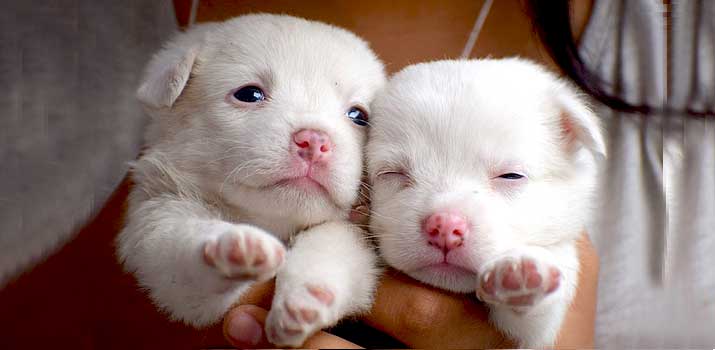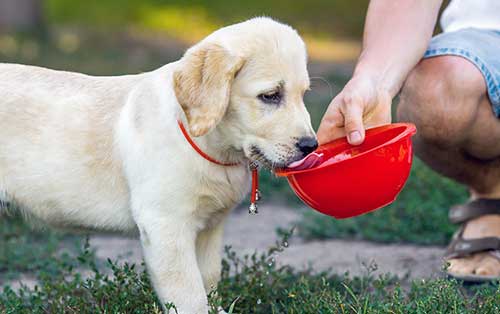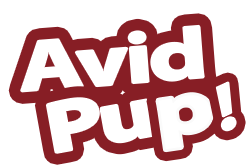
Puppies are a lot like human babies. They’re woefully innocent, incapable of doing much on their own, and require the support of their mothers directly after birth.
Contrary to popular belief, puppies don’t leave the womb and start chowing down. Their eyes aren’t even open yet! While adorable, newborn puppies have plenty of growing still to do.
If you’ve ever wondered why breeders don’t allow eager owners to take puppies home until a few months of age, here’s your answer.
Puppies need time to grow and wean off their mother’s milk. They still rely on their mother to continue developing even after birth.
Breeders typically keep those young ones in a whelping box while they slowly open their eyes, learn to walk, and gain the strength to keep themselves alive.
So, how long until they start eating food and drinking water independently?
Puppy Eating and Drinking Timeline
Generally, puppies gain the ability to eat and drink after their teeth start growing. That’s usually around three to four weeks of age.
Up until that point, puppies will survive exclusively on their mother’s milk. That’s a big reason why it’s unwise to separate puppies and mothers too early.
While providing puppy formula is possible, most experts consider natural milk a far better option.
Milk is chock-full of the essential nutrients puppies need to develop.
In just the span of a few weeks, you’ll see dramatic changes in the litter. They go from helpless newborns to fully function young dogs full of personality and life.
Not only that, but they tend to multiply in size right before your eyes!
That’s because the milk has everything they need. An artificial formula can replicate milk, but mothers typically have a steady supply for the entire litter.
Related: How Many Puppies Can a Dog Have
Can You Wean Puppies Off Before Teeth Come In?
You might find yourself tempted to try and get your puppy off their mother’s milk before they’re ready to. We recommend resisting that urge and letting nature work its course.
We can’t stress enough how important it is for a puppy to consume milk or formula.
Standard commercial dog food simply isn’t made for the extreme growth in young puppies. Taking them off milk too early can lead to severe developmental issues that could affect the puppy their entire lives.
Furthermore, they could end up malnourished and on the verge of death before getting a chance at life.
Even water can be an issue.
Puppy stomaches aren’t developed enough to handle water and traditional food. The digestive system isn’t ready for any of that yet, so providing food or water could lead to potentially life-threatening problems.
It’s best to let puppies consume milk until they’re ready to move on.
What About Weaning After the Teeth Come In?
On the opposite side of the coin, we have puppies that wean for too long. Three to four weeks is the average for most canines.
You can pay attention to their behavior to determine when they start teething.
As those tiny teeth poke through the gums, it’s time to start getting off mother’s milk.
Now, some puppies will need a little longer. Runts might have to stay on milk for an additional week to make up for the slower development. But they’ll be ready once teeth come in, too.
You must support the transition to puppy food and water. Failure to do so can lead to just as many complications as weaning puppies off too early.
First, mothers will suffer. Feeding with teeth is not a comfortable experience for mothers. It’s downright painful in an area that’s already quite sensitive.
It’s not uncommon for teething puppies to cause bleeding and other issues. That could eventually turn into infections and put the mother’s health at risk as she’s trying to recover from pregnancy and birth.
For the puppies, waiting too long to wean could harm their development.
The needs of a newborn are far different from the needs of a growing puppy. Transitioning to nutrient-rich puppy food will ensure that they can continue healthily on their path to adulthood.
Related: Does Teething Cause Diarrhea in Puppies?
Introducing Water to a Young Puppy

It seems like a simple enough task. However, many puppies are fearful of their own reflection and every brand-new experience they go through!
These young pups don’t know anything, and it can take some time to get used to drinking water.
There’s not much you can actively do to speed things up.
The best course of action is to let puppies figure things out independently. This might take several hours or even days. However, they will eventually get the hang of things.
One technique many breeders use is placing the water bowl near the mother’s water bowl. You may even want to consider letting them share a bowl if the mother isn’t super territorial.
Either way, having the mother’s support nearby makes a big difference. The puppies can watch her drink to learn the ins and outs of staying hydrated.
Meanwhile, the mother can stop the puppy from making messes or dunking its entire head into the bowl.
Related: How Much Water Should A Puppy Drink During Potty Training?
Here’s a tip to make things a little easier:
Use a plastic bowl.
Hold off on the reflective metal bowls or massive gravity-based waterers. The former can alarm the puppy with their reflection.
With the latter, the gurgling sounds and bubbles could be off-putting.
Keep things simple, and let your pups learn the ropes. Once they get comfortable, you can switch to whatever waterer you want!
Weaning Puppies to Commercial Food
Getting puppies to eat food is a little more of a challenge.
New foods are foreign to young canines, and they might show natural hesitation toward anything that’s not milk.
Some dogs will dive right in, but most will need a bit of adjustment.
The best way to introduce commercial food is to soften it.
You can do that by adding a bit of warm water or formula.
Use a fork to mash the meal up for dry foods and create a lickable consistency. Something like oatmeal is ideal.
For wet canned food, use a little less water or formula. You’ll still need to mash things up and create a soft texture, but the food’s moisture content should make that easy.
The goal is to make the food easy to consume.
Crunchy textures can be uncomfortable for puppies that have spent all of their short lives eating liquid milk. The smell should draw puppies in.
Once they have that first taste, they’ll become more adventurous.
Most experts recommend softening food for several days or weeks as the teeth develop. Add less and less moisture once you feel your pup can handle some crunch.
Eventually, you can stop adding water or formula altogether and let your pup continue eating food as it comes.
When planning your puppy’s meal, create small windows of opportunity to eat.
Puppies shouldn’t eat their entire daily caloric intake in one sitting. It would be best to split it up to give them ample time for digestion and absorption.
Ideally, you’ll start with four small meals a day. Continue with four meals until your dog is about four months old. Then, you can take one away and transition to three meals.
You can move to two meals a day when your dog is six months old.
Which is Better: Dry or Wet?
Here’s a point of discussion among many breeders and puppy owners.
You’ll hear people claiming that one type of food is better than the other. However, these foods both have their advantages and disadvantages.
Let’s start with dry food.
Dry kibble is readily available at most stores. It’s typically cheaper, easier to store, and has a relatively long shelf life.
The crunchy texture is great for cleaning your dog’s teeth once they fully develop, but it can be harder for young pups.
Wet food is on the pricier side and can be much messier. But, it’s usually more enticing and can help keep dogs hydrated thanks to its higher moisture content.
While not as protein-packed as dry food, it’s still plenty nutritious if you get the right formula.
Ultimately, both options are fine. The right choice for you depends on your budget and what your dog likes.
The Importance of Puppy Formulas

It doesn’t matter whether you get dry food or wet food. However, the detail that does matter is the formula.
Always get dog foods that are specifically made for the needs of growing puppies. The worst thing you can do is provide your young dog with a “universal” formula or one created for adults.
Puppies are still growing and will continue to do so after their first birthday.
Their bodies undergo major changes that require more fuel than their adult counterparts.
Puppy formulas tend to have slightly more protein to support developing muscles. They also have just the right amount of calcium and phosphorous to help bones.
Many also have additional nutrients like DHA for brain and eye development.
Giving a puppy an adult dog food formula can be detrimental to their health.
It can deprive them of the nutrients they need, leading to deformities and debilitating health issues in the future.
If there’s one thing you need to pay attention to, it’s the type of food you give.
Always stick to puppy foods with high-quality proteins, no artificial fillers, and nothing but healthy ingredients.
Related read: Bad Dog Food Brands You Should Avoid This Year
How Much Food and Water Do Puppies Need Daily?
A puppy’s needs will change pretty dramatically as they grow.
In the beginning, meals will be pretty small. Many breeders and trainers also recommend being wary about water intake.
Leave puppies with too much water, and you could have many accidents on the horizon. Young dogs have relatively weak bladder control, so excessive drinking could be problematic.
When they first start drinking water at four weeks old, a half-cup of water every few hours is enough to keep them hydrated.
Eventually, you can move to open water access. That should come when your puppy is house-trained and capable of not having frequent accidents.
So what about food?
Puppies will need more and more food as they grow.
Vets recommend adjusting meal size based on weight, age, and body condition in most cases.
Every dog develops differently, so you’ll need to be proactive about ensuring your pup gets all the nutrition they need.
Take a look at the feeding guidelines on the back of your dog food package. Then, consult with your vet.
Always keep your vet in the know, and don’t be afraid to ask for advice if you’re unsure. Don’t forget that the figures you see on packaging usually apply to daily intake requirements.
If you’re splitting up your puppy’s daily intake into four meals, you’ll need to consider individual serving sizes to get things right.
Weaning the Right Way
To sum up: Puppies are ready to wean off their mother’s milk and move to puppy food and water when they’re about four weeks old.
Once their teeth start to come in and nursing becomes painful for the mother, it’s time to wean! Use the information above to do things right.
Make sure your puppy is ready for the transition. Be patient and give your pup all the time they need to get used to things.
As long as you have the right food and plenty of clean water on hand, they’ll get the hang of things in no time!
Also Read: Dog Won’t Eat His or Her Food But Will Eat Treats

